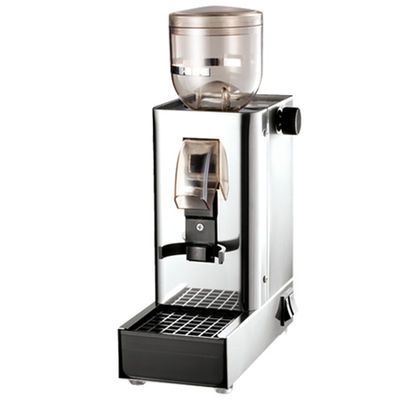Pasquini Lux
From Whole Latte Love Support Library
The Pasquini Lux is an electric burr grinder.
| Pasquini Lux |
|---|
| Manufacturer: Pasquini |
| Model Name: Lux |
| Type: Electric burr grinder |
Contents
Machine Description
Pasquini designed the Lux Grinder to complement the professional quality and compact size of the Livietta Espresso Machine. With a height of just over 13 inches, the Lux Grinder is significantly smaller than Pasquini’s other grinders. The Lux’s housing and frame are made of heavy cast aluminum. It has a chrome finish and a removable plastic grate to catch spilled coffee grounds, ensuring that your countertop stays clean.
The Pasquini Lux gives you 2 different options to grind for single batches or in larger quantities. The grinder has a built-in portafilter holder and micro-switch to grind directly into your portafilter. For larger amounts, the Lux has a continuous grind switch next to the power switch, which can grind for up to 1 minute and 30 seconds continuously. The adjustment knob on the right side of the machine is designed to give you complete control over the grind. A full turn of the knob will make very subtle changes to the fineness level, or turn the knob several turns to make large changes. The grind adjustment knob allows you to customize your grind for anything from French press to very fine espresso. As you turn the adjustment knob, the scale on the bean hopper will rotate to show you what setting the Lux is at, so it’s always easy to fine-tune it exactly to your needs.
The Pasquini Lux features heavy duty conical burrs to evenly crush and disperse coffee beans quickly into your portafilter. Powered by a 150-watt motor, the Lux is designed to stand up to the high demands of heavy home use.
The bean hopper on the Lux is made of sturdy tinted plastic to protect the freshness of the beans. The top lid lifts off for easy filling, and the grind adjustment scale is easily visible along the base of the bean hopper. The built-in spill grate is a rare feature found on home grinders, protecting your counter from excess coffee grounds. It can be removed for emptying, and its plastic construction is durable and easy to clean.
Basic Usage
The manufacturer of the machine released a two part video showing the basic usage of the grinding with a Pasquini Livietta.
Cleaning & Maintenance
Burr Cleaning & Calibration
The grinder should be taken apart for cleaning and calibration every 25 lbs of coffee or every 6 months, whichever comes first. The burrs will slowly move out of calibration with use, and coffee residues and grounds will collect over time and create stale flavors.
Troubleshooting
Machine Not Powering On
- First plug the machine into another outlet. Make sure the machine is the only device on the outlet, and that the outlet works with other appliances.
- Try backing out the grind to a coarse setting. If the burrs are too close together they will not be able to move.
- Try using the machine on a different outlet, and make sure the machine is the only appliance plugged into that outlet.
- If the machine still is not working then there may be a loose wire internally.
- Once the machine is powering back on, reassemble the grinder and make sure the grind is set to the coarsest setting. Add beans back in and test the machine.
- If the beans grind correctly on this setting slowly move the grind setting to the desired position. Only adjust the grind size while the grinder is running or you risk jamming the grinder or blowing out the fuse again.
Motor On But Beans Won't Grind
If you hear the motor activating but there is nothing being ground, then the burrs are blocked. Make sure not to use oily, caramelized, or flavored beans in the grinder if you are going to be using the grinder for an espresso grind. These types of beans have a lot of sticky residues that can cause jams. Damage caused by use of these beans is often not covered under warranty.
- If the machine is set to a very fine grind, then the burrs may be touching each other. Back the machine off to the coarsest grind setting and see if it's able to grind.
- If the machine is able to grind on this setting, then the burrs were most likely too close together, or the grinder was adjusted when it was off. Try moving the grind back down slowly while the grinder is running. Adjustments should only be made while the grinder is running to prevent jams. Do not set the grind too fine; if the grind is in the Turkish range, like baby powder, then it is set too fine and the machine could jam again.
- If the machine is not able to grind on this setting, then there is a more serious jam. Please refer to the cleaning and maintenance icon above for instructions on burr cleaning and calibration. Once the grinder is cleaned and calibrated, it is important that the machine is set to a coarse grind before using it again. Setting the grind to a fine grind can cause it to jam again.
Grinds Coarse/Inconsistent
- If the machine is on a fine setting and the grinds are still coarse, or if the machine is producing grinds of all different sizes, then the grinder is out of calibration or needs to be cleaned. Please refer to the cleaning and maintenance icon above for instructions on burr cleaning and calibration.
- Oily, caramelized, or flavored beans can cake up on the burrs and push them out of calibration, so these beans should be avoided.
- Additionally adjustments to the grind fineness should only be made while the grinder is running. Moving the burrs closer together for a fine grind will cause them to press against any bean fragments or grinds already in the grinder.
- If the burrs are moving, those fragments get ground up and brushed aside.
- If the burrs aren't moving, then they will press into those fragments and cause the burr to get pushed out of alignment.
- Additionally adjustments to the grind fineness should only be made while the grinder is running. Moving the burrs closer together for a fine grind will cause them to press against any bean fragments or grinds already in the grinder.
- If the grinder is older, or if something was put through the grinder that is not meant to be put in it, the burrs may be worn out. If cleaning and calibrating the grinder is not resolving the behavior then it may be time to replace the burrs.
Diagrams & Manuals
| Electrical Diagram: | |
| Machine Manual: | |
| Parts Diagram: | |
| Service Manual: | |
| Startup Guide: | |
Specifications
| Basic Specs | |
|---|---|
| Width: | 4.4 in. |
| Height: | 13.4 in. |
| Depth: | 9.1 in. |
| Weight: | 13 lbs |
| Wattage: | 150 |
| Voltage: | 120 |
| Housing | |
| Clearance Height For Portafilter: | 2 in. |
| Built-In Tamper: | No |
| Bean Hopper Material: | Plastic |
| Removable Hopper: | Yes |
| Usage | |
| Grind Selection: | All Grinds |
| Recommended Applications: | Home / Commercial |
| Components | |
| Grinding Method: | Burr |
| Burr Type: | Conical |
| Burr Material: | High Grade Steel |
| Burr Size: | 50 mm |
| Capacity | |
| Bean Hopper Capacity: | 8.8 |
| Dispensing | |
| Dosing Options: | Doserless |
| Portafilter Compatibility: | All |
| Controls | |
| Number Of Grind Settings: | Infinite |
| Programmable Grinding: | No |
| Details | |
| Country Of Manufacture: | Italy |
| NSF Certified: | No |

